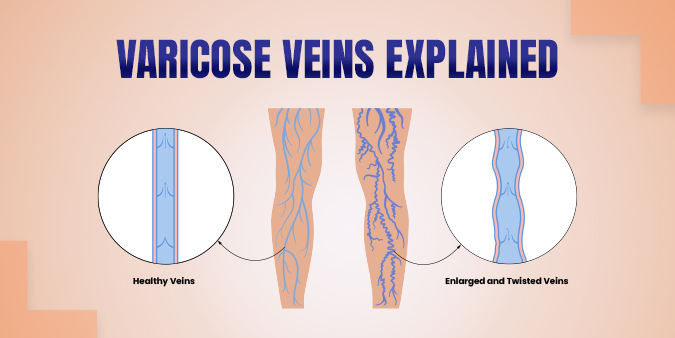
Varicose Veins Explained: Why They Happen and How to Prevent Them
Thursday, 30th May 2024Varicose veins are a common condition that affects many people, particularly as they age. Understanding why they happen and how to prevent them is essential for maintaining healthy legs and avoiding discomfort. This article explores the causes of varicose veins and offers practical tips on prevention.
What Are Varicose Veins?
Varicose veins are enlarged, twisted veins that typically appear in the legs. They occur when the valves in the veins, which help regulate blood flow, fail to function properly. This causes blood to pool in the veins, leading to swelling and the characteristic blue or purple appearance of varicose veins.
Why Do Varicose Veins Happen?
Weak or Damaged Valves
The primary cause of varicose veins is weak or damaged valves in the veins. Normally, these valves open and close to help blood flow back to the heart. When they don’t work properly, blood can flow backward and pool in the veins, causing them to enlarge.
Increased Pressure in the Veins
Increased pressure in the veins can also lead to varicose veins. This pressure can result from various factors, including prolonged standing or sitting, which makes it harder for blood to flow back to the heart.
Age
As people age, the veins and valves can naturally weaken and lose elasticity. This can contribute to the development of varicose veins.
Genetics
A family history of varicose veins can increase your risk. Genetics can influence the structure and strength of your veins, making you more susceptible to this condition.
Hormonal Changes
Hormonal changes, particularly in women, can affect vein health. Hormones such as estrogen can relax vein walls, leading to varicose veins. Hormonal changes during pregnancy, menopause, or from using birth control pills can also increase the risk.
Obesity
Obesity can put extra pressure on the veins, especially in the legs. This additional pressure can weaken the vein walls and valves, leading to varicose veins.
Pregnancy
During pregnancy, the volume of blood in a woman’s body increases to support the growing fetus. This can enlarge the veins and increase the risk of varicose veins, especially in the legs.
Lack of Movement
A sedentary lifestyle can contribute to the development of varicose veins. Regular movement helps maintain healthy blood flow, while prolonged periods of inactivity can cause blood to pool in the veins.
Symptoms of Varicose Veins
Common symptoms of varicose veins include:
- Visible veins: Twisted, blue or purple veins that are visible under the skin.
- Pain or aching: Legs may feel heavy, achy, or painful.
- Swelling: Swelling in the legs, ankles, and feet.
- Itching or burning: Skin around varicose veins may itch or burn.
- Cramping: Leg cramps, especially at night.
- Skin changes: Skin around the varicose veins may become discolored or develop ulcers.
How to Prevent Varicose Veins
While some risk factors for varicose veins, such as age and genetics, cannot be controlled, there are steps you can take to reduce your risk.
Maintain a Healthy Weight
Maintaining a healthy weight can reduce the pressure on your veins and lower your risk of developing varicose veins. A balanced diet and regular exercise can help achieve and maintain a healthy weight.
Exercise Regularly
Regular exercise helps improve circulation and strengthen the muscles that support your veins. Aim for at least 30 minutes of moderate exercise most days of the week. Activities like walking, swimming, and cycling are particularly beneficial.
Avoid Prolonged Standing or Sitting
Avoid prolonged standing or sitting by taking regular breaks to move around. If you have a job that requires long periods of standing or sitting, try to take breaks every hour to stretch and walk around.
Elevate Your Legs
Elevate your legs when resting to help improve circulation and reduce pressure on your veins. Try to elevate your legs above the level of your heart for 15 minutes several times a day.
Wear Compression Stockings
Compression stockings can help improve blood flow and reduce swelling. They apply gentle pressure to your legs, helping your veins and muscles move blood more efficiently. Consult your doctor to find the right type and fit for your needs.
Avoid Tight Clothing
Avoid wearing tight clothing around your waist, legs, and groin, as it can restrict blood flow and contribute to varicose veins.
Eat a Healthy Diet
A healthy diet rich in fiber and low in salt can help prevent varicose veins. Fiber helps prevent constipation, which can increase pressure on the veins, while reducing salt intake can help prevent water retention and swelling.
Stay Hydrated
Staying hydrated is important for overall vascular health. Drinking plenty of water helps maintain healthy blood flow and supports vein function.
Conclusion
Varicose veins can cause discomfort and affect the appearance of your legs, but understanding their causes and taking preventive measures can help reduce your risk. By maintaining a healthy weight, exercising regularly, avoiding prolonged standing or sitting, and wearing compression stockings, you can support your vein health and prevent varicose veins. If you experience symptoms of varicose veins, consult with your healthcare provider to discuss appropriate prevention and treatment strategies.


